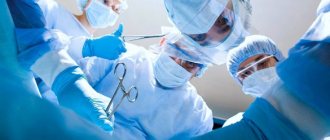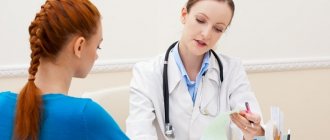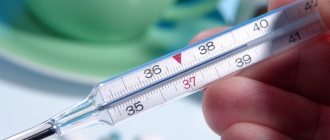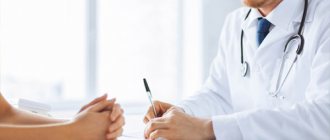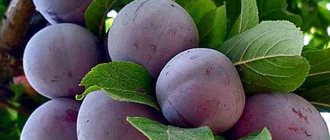Causes of attack
An attack of cholecystitis develops for many reasons. Here are the most common:
- cholelithiasis;
- infection in the bile ducts;
- stomach diseases leading to disruption of bile movement;
- bile stagnation;
- blockage of bile duct vessels as a result of atherosclerosis.
The disease most often occurs in women. The reasons for this gender predisposition to cholecystitis are as follows:
- compression of the gallbladder during pregnancy;
- features of the hormonal balance of women: progesterone negatively affects the condition of the gallbladder;
- Due to frequent dieting, disorders of the contractile function of the gallbladder are observed specifically in women.
Medical statistics claim that in the vast majority of cases, cholecystitis occurs due to complications of gallstone disease. An attack occurs when gallstones disrupt the contractile function of the bladder and destroy its mucous membrane.
In almost all patients, the trigger for the development of an attack is poor nutrition. Intense formation of bile is caused by fatty and spicy foods. It leads to increased pressure in the gallbladder duct system and spasm of the bladder sphincters.
Patients with hypoacid gastritis need to know that constantly reduced acidity of gastric juice leads to the activation of pathogenic microflora of the stomach and its penetration into the gallbladder.
We recommend reading:
Prevention of cholecystitis
Essence of the disease
Cholecystitis in medicine is a disease that is accompanied by the development of an inflammatory process in the walls of the gallbladder. The disease is so dangerous that the mortality rate exceeds acute appendicitis, gastric and duodenal ulcers, as well as strangulated hernia and intestinal obstruction in acute form. Therefore, it is very important to identify the diagnosis as early as possible and begin treatment.
Pathology develops as a result of infection from the blood, lymph or digestive system into the gallbladder. The development of the disease can also be facilitated by a condition in which bile is not excreted from the organ. This may happen in the following cases:
- with kinking or stenosis of the bile ducts;
- in the presence of cholelithiasis, when the resulting stones interfere with the normal excretion of bile.
Often the occurrence of cholecystitis may be preceded by:
- previous operations;
- injuries;
- prolonged fasting;
- increased pressure of the biliary tract;
- diseases of the digestive system;
- sepsis;
- chronic foci of infection, etc.
Signs of the disease appear after a heavy intake of fatty or spicy foods.
As practice shows, symptoms appear suddenly, and their intensity gradually increases. Initially, the patient experiences cramping painful sensations in the right hypochondrium, the strength of which increases over time, and after some time they become permanent. The duration of the attack can be several hours. In this case, quite often the patient experiences profuse vomiting mixed with bile. Other signs of pathology include the appearance of plaque and dry tongue, limited mobility of the abdominal wall on the right side, rapid heartbeat, elevated body temperature and chills.
When one or more symptoms of cholecystitis appear, it is very important that the patient receives first aid correctly and immediately. This point plays a very important role in preventing the development of severe consequences for the patient.
Clinical symptoms of an attack of acute cholecystitis
At the beginning of the attack, patients feel a sharp pain in the right hypochondrium. Pain always occurs unexpectedly, against the background of well-being. It may go away on its own, but most often can be calmed by taking a strong pain reliever. However, the pain soon becomes more intense. The pain may develop as biliary colic.
Symptoms of biliary colic are:
- pain in the right hypochondrium. It can be sharp, the same as during an attack of acute pancreatitis, or dull;
- during an attack of severe pain, patients rush about and cannot find a place for themselves;
- progressive weakness develops;
- blood pressure drops;
- bloating and severe abdominal tension.
In addition, other characteristic symptoms develop, leading to a rapid deterioration of the patient’s condition:
- increase in the patient's body temperature;
- vomiting and nausea;
- the occurrence of jaundice of the skin and sclera. It develops when the physiological flow of bile into the intestines stops;
- increased heart rate. If its frequency exceeds 120 beats per minute, this indicates serious changes in the body;
- When pressing in the right hypochondrium, severe pain occurs.
Types of cholecystitis
Signs of calculous cholecystitis
Depending on how deeply the walls of the gallbladder are affected, the following types of cholecystitis can be distinguished:
- Catarrhal. The inflammatory process is superficial.
- Phlegmonous. Damage occurs to all layers of the organ with the formation of pus.
- Gangrenous. In this case, the walls partially or completely die. The complicated form is characterized by tissue breakthrough with the release of bile into the abdominal space.
A mild exacerbation is considered if the duration of symptoms is less than 72 hours and they are mild. The average degree of development of the pathology is characterized by a duration of sensations of more than 3 days, and the gallbladder can be felt by palpation.
In severe cases, the patient experiences a decrease in blood pressure, impaired breathing and heartbeat, and an increase in temperature to high levels. If first aid is not provided on time, the patient may die.
Complications of peritonitis
The progression of cholecystitis leads to peritonitis (inflammation of the peritoneum). There is increased pain throughout the abdominal area. When pressing on the stomach and then sharply withdrawing the finger, the pain intensifies. Vomiting appears, first with admixtures of food debris, and then with greenish contents.
With peritonitis, the general condition is also complicated:
- the skin turns pale, the tongue becomes white;
- palpitations appear;
- body temperature rises;
- the belly increases.
In addition, the development of destructive and perforated cholecystitis is possible. In the case of destructive cholecystitis, patients experience constant pain, complicated by vomiting and high fever. The patient's condition quickly deteriorates, making emergency surgical care necessary.
We recommend reading:
Symptoms and treatment of cholecystitis
With perforated cholecystitis, pain is first noted in the right hypochondrium and then spreads throughout the abdomen. The patient quickly develops symptoms of peritonitis. The advanced form of cholecystitis causes necrosis of the gallbladder, biliary fistula, and sepsis.
Essence of the disease
Cholecystitis in medicine is a disease that is accompanied by the development of an inflammatory process in the walls of the gallbladder. The disease is so dangerous that the mortality rate exceeds acute appendicitis, gastric and duodenal ulcers, as well as strangulated hernia and intestinal obstruction in acute form. Therefore, it is very important to identify the diagnosis as early as possible and begin treatment.
Pathology develops as a result of infection from the blood, lymph or digestive system into the gallbladder. The development of the disease can also be facilitated by a condition in which bile is not excreted from the organ. This may happen in the following cases:
- with kinking or stenosis of the bile ducts;
- in the presence of cholelithiasis, when the resulting stones interfere with the normal excretion of bile.
Often the occurrence of cholecystitis may be preceded by:
- previous operations;
- injuries;
- prolonged fasting;
- increased pressure of the biliary tract;
- diseases of the digestive system;
- sepsis;
- chronic foci of infection, etc.
Signs of the disease appear after a heavy intake of fatty or spicy foods.
As practice shows, symptoms appear suddenly, and their intensity gradually increases. Initially, the patient experiences cramping painful sensations in the right hypochondrium, the strength of which increases over time, and after some time they become permanent. The duration of the attack can be several hours. In this case, quite often the patient experiences profuse vomiting mixed with bile. Other signs of pathology include the appearance of plaque and dry tongue, limited mobility of the abdominal wall on the right side, rapid heartbeat, elevated body temperature and chills.
When one or more symptoms of cholecystitis appear, it is very important that the patient receives first aid correctly and immediately. This point plays a very important role in preventing the development of severe consequences for the patient.
What to do during an attack of cholecystitis
An attack of cholecystitis requires emergency care. At home, first aid to a patient should be as follows.
- An ambulance should be called first.
- The patient should be in a horizontal position.
- Put cold on your stomach.
- To relieve pain, you need to give an antispasmodic. Most often these are No-shpa, Papaverine, Baralgin.
- To relieve attacks of nausea, you need mint tea, as well as still mineral water.
- When vomiting, you must prevent your tongue from falling back. After vomiting, give mineral water. It should be drunk in small sips.
Urgent medical care
After the victim is taken to a medical facility, he will be provided with emergency assistance:
- A thorough examination of the patient, which allows us to assess the severity of his condition and determine further treatment tactics.
- Elimination of unbearable pain with the use of antispasmodic and analgesic drugs that are administered by injection.
- Detoxification of the body is carried out using saline solutions.
- Taking measures to prevent bile stagnation.
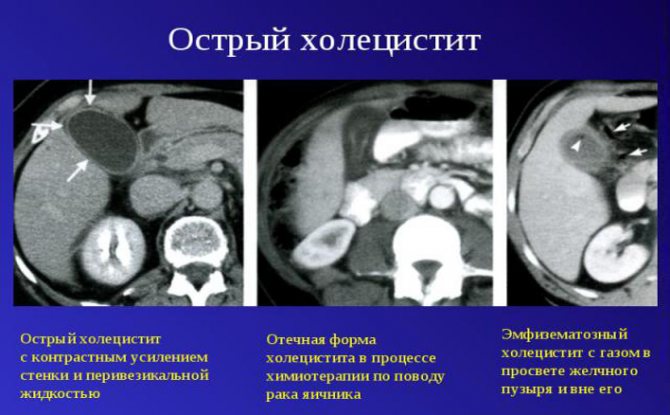
All of these measures make it possible to reduce the bright manifestation of signs of the disease, after which doctors begin conservative or surgical treatment. Therapy is determined in each case individually.
Only after doctors have provided first aid, drug therapy for the disease itself is carried out.
If conservative treatment does not produce the desired results within 24 hours, then a decision is made to perform surgery.
Failure to provide first aid at the time of a developing attack of cholecystitis risks the development of a number of complications such as inflammation of the pancreas, liver, bile ducts, diffuse peritonitis or blood poisoning.
Treatment of an attack
In most cases, treatment of an attack of acute cholecystitis cannot occur at home, so patients require hospitalization in the surgical department of the hospital. Conservative treatment of cholecystitis consists of prescribing antispasmodics, antibiotics, and detoxification medications to the patient.
After acute symptoms have subsided, the patient is prepared for elective gallbladder removal.
Peritonitis requires emergency surgical treatment. If the disease is advanced, then repeated lavages of the abdominal cavity are performed. Urgent surgery is also performed when an attack of cholecystitis does not go away.
Prevention of an attack of acute cholecystitis consists of a diet limiting spicy, smoked and fatty foods, and alcoholic drinks. An active lifestyle and timely treatment of liver and stomach diseases are necessary. If digestive diseases occur, you should immediately consult a doctor.
Urgent medical care
After the victim is taken to a medical facility, he will be provided with emergency assistance:
- A thorough examination of the patient, which allows us to assess the severity of his condition and determine further treatment tactics.
- Elimination of unbearable pain with the use of antispasmodic and analgesic drugs that are administered by injection.
- Detoxification of the body is carried out using saline solutions.
- Taking measures to prevent bile stagnation.
All of these measures make it possible to reduce the bright manifestation of signs of the disease, after which doctors begin conservative or surgical treatment. Therapy is determined in each case individually.
Only after doctors have provided first aid, drug therapy for the disease itself is carried out.
If conservative treatment does not produce the desired results within 24 hours, then a decision is made to perform surgery.
Failure to provide first aid at the time of a developing attack of cholecystitis risks the development of a number of complications such as inflammation of the pancreas, liver, bile ducts, diffuse peritonitis or blood poisoning.
Principles of specialized therapy
To provide first aid at home, it is necessary to put the patient to bed, applying ice to the stomach. Then you should call an ambulance.
Antispasmodic drugs (No-shpa, Papaverine, Baralgin) will help relieve pain, and mint tea will soothe the stomach, eliminating nausea. Water without gases, but enriched with minerals, has a beneficial effect on the patient’s well-being.
It should be consumed in small sips.
Self-medication leads to complications, so you should not do an enema, use a heating pad, or take pharmaceuticals without a doctor’s prescription. Treatment of acute cholecystitis involves the use of antibiotics, hepatoprotectors, antispasmodics and choleretic agents.
After confirming the diagnosis, treatment for an attack of cholecystitis will consist of the following components:
- Strict diet. For a long time you need to forget about spicy, fried, smoked foods, alcohol, and soda.
- Antibacterial therapy. Most often, third generation cephalosporins are used in the treatment of cholecystitis.
- Rehydration. Against the background of intoxication and vomiting, the patient is in a state of dehydration. Treatment of dehydration consists of intravenous administration of saline and colloid solutions.
- Hepatoprotectors. Milk thistle or Heptral are usually prescribed.
- Antispasmodics and analgesics are used according to indications to relieve a pain attack.
An attack of cholecystitis is usually provoked by errors in diet. Its symptoms are very similar to appendicitis, so diagnosis must be done in a hospital.
Self-medicating at home is not only ineffective, but also very dangerous. Treatment of cholecystitis should be carried out under the supervision of a physician.
Treatment of attacks of cholecystitis is based on taking medications, as well as using recipes from traditional medicine. In severe cases, the patient faces surgical intervention.
If you are ill, it is important to follow a diet that excludes fried foods, fatty foods, smoked foods, canned food, sausages, chocolate, alcohol and carbonated drinks. It is allowed to consume vegetarian light soups and dairy products, various cereals, vegetables cooked steamed or in a slow cooker, fish and meat using the same method of preparation as vegetables.
Drinks the patient is allowed are juice, tea, jelly, compote and fermented milk products.
Therapy for cholecystitis is based on taking herbs and medications with a choleretic effect. You should not take choleretic drugs if there are stones in the gallbladder, so it is important to follow your doctor’s recommendations and not self-medicate.
If the patient is experiencing severe pain, it is recommended to take medications that can suppress muscle spasms.
Symptoms
An attack of cholecystitis manifests itself with different symptoms depending on the form of the course. However, both chronic and acute pathology have common symptoms. Acute inflammatory process of the gallbladder can be recognized by the following symptoms:
- nausea;
- vomit;
- diarrhea or constipation;
- bloating;
- bad breath.
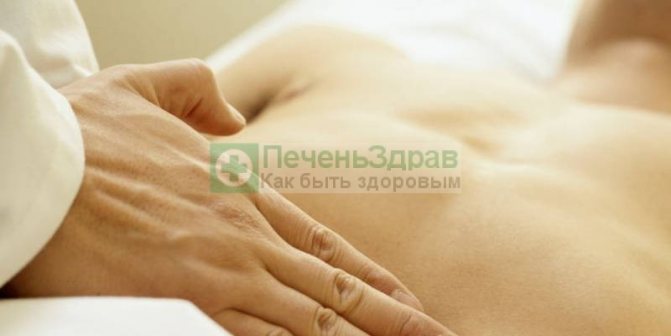
In the acute form, the following indicators are added to these signs:
- bitter taste in the mouth;
- fever;
- noticeable enlargement of the liver.
And attacks of chronic cholecystitis are characterized by the following symptoms:
- heaviness in the stomach;
- bloating;
- nausea;
- bitterness in the mouth;
- low temperature;
- thickening of the bladder walls.
The symptoms of a primary or secondary attack will be the same in both the first and subsequent episodes. The patient will feel the same pain as during an acute illness.
Prognosis and prevention
According to doctors, the best way to prevent recurrent attacks is diet. To prevent cholecystitis, the patient needs to follow the doctor’s instructions, eat right, walk in the fresh air and take medications prescribed by the attending physician.
With drug treatment of mild forms of cholecystitis, it is possible to completely eliminate unpleasant symptoms and prevent complications. If the medications were selected inadequately, the disease may become chronic. When a patient develops complications, the risk of death increases significantly.
During an exacerbation, patients are advised to drink fluids. If you manage to get rid of the severe symptoms of the attack, you can include steamed dishes (vegetables, meat or fish) in the menu.
Fiber puts a strain on the digestive system. Therefore, it is contraindicated for cholecystitis.
Meals should be frequent and portions small. This will ensure constant and measured functioning of the gastrointestinal tract.
It is recommended to take the last meal of the day several hours before bedtime. Groups of products contraindicated for cholecystitis:
- smoked meats and canned food of all types;
- products that promote the formation of gases in the gastrointestinal tract;
- foods that affect stomach acidity.
Prevention of an attack of cholecystitis includes strict adherence to diet, giving up bad habits, performing moderate physical activity, and monitoring diseases of the gastrointestinal tract and internal organs.
zdorpechen.ru

